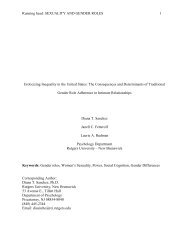Sources of self-categorization as minority for mixed race individuals
Sources of self-categorization as minority for mixed race individuals
Sources of self-categorization as minority for mixed race individuals
Create successful ePaper yourself
Turn your PDF publications into a flip-book with our unique Google optimized e-Paper software.
<strong>Sources</strong> <strong>of</strong> Self-Categorization 17show similar physical features, and hence rely less on appearance when considering racial or<strong>minority</strong> similarity. Finally, we may simply have me<strong>as</strong>ured connectedness more effectively thanappearance, allowing <strong>for</strong> evidence <strong>of</strong> stronger relationships with other study variables.The present study also demonstrates that <strong>self</strong>-<strong>categorization</strong> <strong>as</strong> a <strong>minority</strong> may haveimportant practical consequences. Multiracial people may perceive themselves <strong>as</strong> entitled to<strong>minority</strong> scholarships or appropriate <strong>for</strong> affirmative action-b<strong>as</strong>ed resources and benefits reservedexclusively <strong>for</strong> ethnic minorities, only if they <strong>self</strong>-categorize <strong>as</strong> <strong>minority</strong>. Although all <strong>of</strong> ourparticipants possessed at le<strong>as</strong>t one <strong>minority</strong> background, the extent to which they categorizedthemselves <strong>as</strong> <strong>minority</strong> predicted viewing themselves <strong>as</strong> eligible <strong>for</strong> <strong>minority</strong> resources such <strong>as</strong>affirmative action. Thus, the present research applies Wenzel’s work to category-b<strong>as</strong>edentitlements <strong>for</strong> <strong>minority</strong> groups (Wenzel, 2000), showing that participants who <strong>self</strong>-categorized<strong>as</strong> <strong>minority</strong> also viewed themselves <strong>as</strong> eligible <strong>for</strong> affirmative action. Previous research wouldsuggest that the link between <strong>self</strong>-<strong>categorization</strong> and category b<strong>as</strong>ed entitlements is purelycognitive (i.e., ‘I am a group member, and there<strong>for</strong>e I am entitled to that group’s resources;’Wenzel, 2000). It is also possible that social factors are at play in the <strong>for</strong>m <strong>of</strong> experiences withothers. Multiracial <strong>individuals</strong> who categorize themselves <strong>as</strong> more White may interact morefrequently with Whites and others who may view affirmative action <strong>as</strong> something reserved solely<strong>for</strong> minorities and not multiracial people (Sanchez & Bonam, 2009). These experiences may leadmultiracial <strong>individuals</strong> to “take themselves out <strong>of</strong> the running” <strong>for</strong> affirmative action b<strong>as</strong>edresources. Regardless <strong>of</strong> the re<strong>as</strong>on multiracial <strong>individuals</strong>’ <strong>self</strong>-<strong>categorization</strong> <strong>as</strong> <strong>minority</strong>predicts perceived eligibility <strong>for</strong> affirmative action, the findings <strong>of</strong> the current study have realworld implications <strong>for</strong> biracial and multiracial <strong>individuals</strong> who qualify <strong>for</strong> affirmative action, yetmay not receive these benefits because they do not view themselves <strong>as</strong> sufficiently <strong>minority</strong>.



